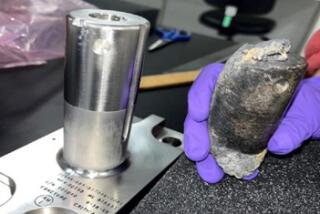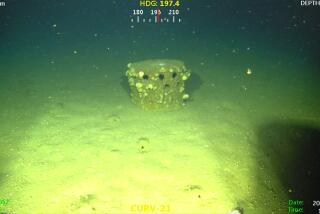Parts Found by Sub May Solve Shuttle Puzzle
- Share via
KENNEDY SPACE CENTER, Fla. — Parts of what may be the right solid rocket booster believed to have triggered the explosion of the space shuttle Challenger were found Sunday 40 miles off Cape Canaveral, National Aeronautics and Space Administration officials said.
A four-man research submarine discovered the debris at mid-morning and brought back photographs and videotapes that will be studied to confirm the finding sometime today, NASA spokesman George Diller said.
The pieces could supply the most important clue yet in the effort to identify the cause of the Jan. 28 explosion that destroyed the Challenger and killed its seven crew members.
Most Likely Cause
Photographs of the launching and other evidence point to a failure in the joints of the rocket booster as most likely the cause of the space program’s worst disaster.
Engineers will compare photographs taken Sunday morning with photos of the launching to make a positive identification, Diller said. “They are pretty sure they hit pay dirt,” he said.
Radar tracking of the booster as it swooped away from the shuttle after the explosion had come close to pinpointing the spot where it fell, he said.
NASA officials said that it was too early to tell whether the debris from the rocket will be enough to determine what may have caused it to fail.
“It’s in pieces,” Diller said. A “destruct” signal sent by a range officer to prevent the rocket from hurtling toward a populated area caused it to crash into the ocean.
Diller said, however, that even pieces of the rocket booster will probably provide investigators with the evidence they need.
“We expected they would be broken, but we are only interested in certain key pieces. We don’t need the whole thing,” he said.
The debris was found in 1,200 feet of water by a privately owned research submarine, the Johnson Sea Link II, on contract to the U.S. Navy.
The four-man diving vessel accomplished what human divers--limited to depths of 230 feet--and diving drones, buffeted by heavy currents, could not do over the last several weeks.
Floodlights helped the crew of the vessel, which is equipped with sonar and two video cameras, to probe the murky regions far below the surface of the Atlantic.
Later this week, the Navy is to bring in a 137-foot nuclear-powered submarine with a crew of seven to assist in the search for Challenger debris.
The submarine, NR-1, is capable of diving as deep as 2,375 feet for indefinite periods of time, and can also bring debris back to the surface, said Navy spokesman Art Norton.
If the pieces found Sunday are confirmed to be from the right rocket booster, it is still uncertain when NASA officials will attempt to raise them, Diller said.
Other NASA ships are searching a few miles to the south, where the left solid rocket booster is thought to have fallen.
So far, NASA has recovered 13 tons of metal, thermal tiles and other debris believed to be remnants of the space shuttle. The agency has refused to confirm any finding of human remains or personal effects.
The right solid rocket booster , almost from the beginning, has been the main target of the recovery efforts.
Photographs of the launching show a puff of black smoke emerging from a point at, or just below, a joint in the lower section of the right booster less than half a second after ignition.
Later photos showing a fiery plume in the same area support theories that a seal in the booster failed during ignition, when the rocket is jolted by 3.3 million pounds of thrust within a fraction of a second.
If the rocket booster did spring a leak, it would have sprayed the adjacent fuel tank, loaded with millions of gallons of volatile liquid hydrogen and liquid oxygen, with a 5,000-degree blowtorch, and caused it to explode, some NASA officials have suggested.
Meanwhile, acting NASA Administrator William R. Graham took a step to consolidate his control of the agency over the weekend when he dismissed the top-ranking manager appointed to run day-to-day operations.
20-Year NASA Veteran
In a statement, Graham said Philip E. Culbertson, a 20-year NASA veteran, was being relieved of his duties as general manager, effective immediately.
Culbertson was appointed by Graham with White House approval to handle the daily operations of the agency until a permanent agency chief was designated.
But Graham said in his statement that “a two-tiered senior management structure was proving too cumbersome and slow,” particularly with the demands of the Challenger investigation.
NASA spokesman Charles Redmond said Graham’s decision may have been related to perceptions that he could not get the information he needed quickly enough.
More to Read
Sign up for Essential California
The most important California stories and recommendations in your inbox every morning.
You may occasionally receive promotional content from the Los Angeles Times.







